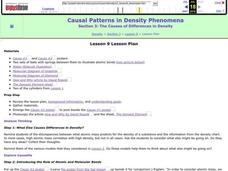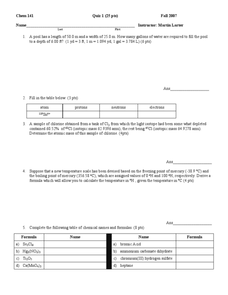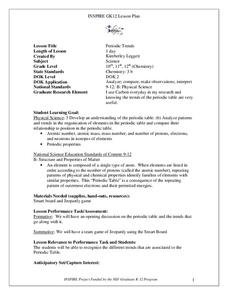Curated OER
Grade 6 Science Quiz
In this grade 6 science quiz, 6th graders complete a 15 question multiple choice quiz covering a variety of grade 6 concepts.
Curated OER
SURVIVING A COSMIC INVASION
Middle schoolers read periodicals relating to radioacitivity and interpret a Geiger Counter. They work in small groups, share information and help each other explain the Geiger Counter. They discover the relationship distance to...
Curated OER
Static Electricity Game
Fifth graders explore further the importance of static electricity by playing a game which reinforces and reviews static electricity concepts.
Curated OER
The Causes of Differences in Density
Students explore what causes differences in density. They observe an models depecting atoms, compounds, and molecules. Students determine if there is air in between atomic bonds. They study the structure and spacing of molecular bonds.
Curated OER
Matter
Fifth graders investigate the structure of matter. They examine pictures of atoms and molecules and discuss their relationships, and construct a model of a molecule using toothpicks and gumdrops.
Curated OER
Periodic Table Lesson Plan
Young scholars describe how elements are arranged on the periodic table. They compare metals, nonmetals, and metalloids based on their properties and on their locations in the periodic table. Students describe the differences between a...
Curated OER
Atoms and molecules
In this chemistry activity, students find the words that are related to atoms and molecules. The answers are found by clicking the link at the bottom of the page.
Curated OER
Astronomy Class
In this space science worksheet, students find the words associated with the basic terms of Astronomy. The answers are located at the bottom of the page.
Curated OER
Absolute Ages of Rocks
In this ages of rock worksheet, students review the processes involved with determining the ages of rocks which includes the radioactive decay of carbon-14. This worksheet has 5 matching and 5 short answer questions.
Curated OER
Calculating the Number of Sub-Atomic Particles in an Atom
In this atoms worksheet, high schoolers compare the position, relative charge and relative mass of sub-atomic particles. Students define mass number and atomic number. This worksheet has 2 graphic organizers and 4 short answer questions.
Curated OER
Quiz 1-Problem Solving and Naming Compounds
In this problem solving worksheet, students are given five problems including calculating volume given the dimensions of a pool, determining the number of subatomic particles in an atom, filling in a table with chemical names and...
Curated OER
The Chemistry of Mineral Worksheet
In this mineral worksheet, students give the name and/or symbol for elements and they distinguish between elements and compounds. They fill in a chart with subatomic particles for given elements and they determine if given substances are...
Curated OER
Density
Students explore the meaning of density. In this density lesson, students use interactive whiteboards to review definitions regarding density and compare the density of selected objects.
Curated OER
How do we know that the theory of evolution is correct?
Students read passages and view a slide show on the theory of evolution and provide evidence that this theory is correct. In this evolution lesson plan, students read about fossils, anatomy, organs, fetal development, and more.
Curated OER
Chemistry E3 Lesson Plan
Ninth graders perform a series of experiment to investigate heat transfer and phase changes. In this physical science instructional activity, 9th graders identify and calculate the different subatomic particles. They explain the...
Curated OER
Forces And Energy
Students investigate the atom and how it is formed. They conduct research using a variety of resources and then construct a model of the atom. Then students have class discussion. The lesson includes background information for the...
Curated OER
What is Radon?
Learners read an article about radon and its properties. They examine a periodic table and identify the numbers surrounding an element. They discuss the harmful and helpful effects of radiation.
Curated OER
What Is Radon?
Students examine what radon is and which isotope it belongs. They discuss the characteristics of isotopes in general and the atomic number. They complete a worksheet to complete the lesson.
Curated OER
Structure of the Atom
Students practice drawing the atomic structure of several different elements. They complete critical thinking questions about atomic structure and compare the atomic mass units for different ions and isotopes of an element.
Curated OER
Periodic Trends
Students identify the different periodic trends. In this chemistry activity, students discuss how elements are arranged in the periodic table. They apply what they have learned in a Jeopardy team game.
Curated OER
Periodic Table Patterns using Fabulous Periodic
Students explain how elements are arranged in the periodic table. In this chemistry lesson, students group the eggs according to a certain pattern. They compare this to elements in the periodic table.
Curated OER
Finding the Spot
Fourth graders use circles to "home in" on particular spots, showing the ability of scientists to locate unseen objects in space. This activity shows how scientists know certain objects exist in space due to the forces exerted by...
Curated OER
Transformation of Energy
Sixth graders explore and discuss how several electrical devices work and what energy conversions occur in each device. They connect a zinc strip to a copper strip with alligator clips and wire, immersing each strip in lemon and check...
Curated OER
Periodic Table Basics
In this elements worksheet, students review the periodic table and how the elements are organized in the periodic table. This worksheet has 5 short answer and 4 fill in the blank questions.
Other popular searches
- Protons Neutrons Electrons
- Protons, Neutrons, Electrons
- Protons, Neutron, Electrons
- Protons, Electrons, Neutrons
- Protons Neutrons, Electrons
- Protons Neutron Electrons
- Neutrons, Electrons, Protons
- Protons Neutrons and Electrons
- Protons , Neutrons, Electrons

























